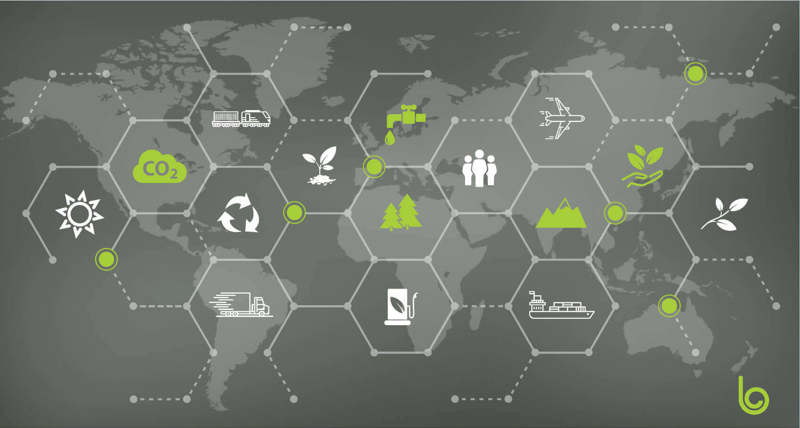Global supply chains are growing and becoming more complex as consumer demand increases. This greater need for products, ingredients and raw materials directly translates into increased environmental impact.
As consumers and organizations become aware of the potential damage caused by global trade and logistics, how can we develop more sustainable supply chains?
One way that organizations can help to reduce the environmental impact of the supply chain is through the smart use of technology. In this article, we’ll explore some of the main changes you can make in your supply chain to improve environmental stewardship, reduce damage and ensure you're sourcing, manufacturing and distributing products in a sustainable way.
The Environmental Impact of Global Supply Chains
Before exploring how technology can help to reduce environmental damage, we need to understand the scale of the problem. A McKinsey report showed that:
- Almost two billion people are expected to become global consumers by 2025, a 75 percent increase over 2010.
- The consumer sector is expected to grow by 5 percent a year for the next 20 years.
- To meet climate change agreements, consumer packaged goods (CPG) companies will need to cut their greenhouse gas emissions by more than 90 percent by 2050.
- More than 90 percent of the damage caused to the environment by CPG companies comes from the supply chain, including 80 percent of greenhouse gas emissions.
- Fewer than 20 percent of supply chain managers say they have visibility into sustainability practices in the supply chain.
The environmental impact in the supply chain isn’t limited to greenhouse gas emissions. Water scarcity, issues with land use, toxic waste, water pollution, deforestation, air quality and energy use are all important considerations.
How Technology Can Build Sustainable Supply Chains
Introducing more ethical and sustainable supply chains is good practice for any business. It will improve regulatory compliance, enhance business branding and reputation, reduce waste and overhead, and reassure consumers on ethical environmental sourcing.
Let’s explore six key ways technology can reduce the environmental impact of supply chains.
1. Drive Efficient Supply and Demand Planning to Reduce Overproduction
Misalignment between supply and demand results in too much or too little production of raw materials, manufacturing of goods or distribution of products. This creates rework and waste that all impact the environment. Artificial intelligence, machine learning and predictive analytics can predict likely demand and ensure much more efficient supply and manufacturing processes.
2. Introduce Transparency to Ensure Suppliers Are Using Ethical Sourcing
Supply chains managers need visibility into how suppliers are extracting or producing raw materials to ensure they’re following sustainability standards. Blockchain technology is a useful way to capture and verify supplier sourcing practices and IoT devices monitor and report on working conditions and environmental factors.
3. Optimize Routes to Reduce Fossil Fuel Consumption
Until logistics moves to electric and other sustainable vehicles, route optimization is one of the best ways to reduce the environmental impact of transportation and distribution. Artificial intelligence can work with GPS devices to optimize international, national and local shipping routes. Advanced analytics can even update routes in real time to take account of congestion and other issues.
4. Consolidate Shipments to Fully Utilize Containers and Transportation
An empty container is a wasted container. Predictive analytics can predict where and when goods are going to arrive and consolidate shipments from multiple suppliers going to multiple final destinations. This makes the most efficient use of assets (i.e., containers, trailers, etc.) and transportation, reducing the total amount of greenhouse gasses generated per unit of cargo.
5. Plan Around Existing Environmental Risks and Impacts
Many supply chains are already impacted by climate change and other environmental factors. Issues like wildfires on the west coast of the U.S., rising sea levels, water scarcity or lower agricultural yields have a profound impact on the efficiency, quality and speed of the supply chain. Supply chain technology helps to predict these risks and allows supply chain managers to mitigate the impact and put contingency plans in place.
6. Streamline Supply Chain Processes to Reduce Waste
Supply chains can be improved through major changes, but it’s more common to see results through small, iterative improvements. Good analytics and reporting works with machine learning to continually improve processes throughout the supply chain. Every change that slightly reduces waste, speeds up delivery or enhances quality can make a tiny, incremental improvement to sustainability.
The Bottom Line
The environmental impact of supply chains will continue to be a major issue for supply chains, with organizations and consumers becoming more aware of how goods are sourced, manufactured and distributed. A forward-looking supply chain strategy combined with the right technology solutions will help organizations build more sustainable, responsible and ethical supply chains—and that’s good for everyone.
Learn how Blume Optimization maximizes asset utilization, minimizes empty miles and reduces carbon emissions.
contact us
Contact Us

